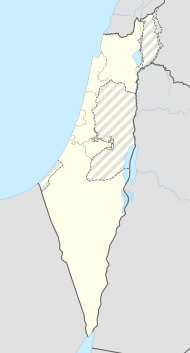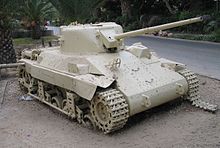Negba
| Negba | ||
|---|---|---|
| Basic data | ||
| hebrew : | נגבה | |
| State : |
|
|
| District : | south | |
| Founded : | July 12, 1939 | |
| Coordinates : | 31 ° 40 ′ N , 34 ° 41 ′ E | |
| Height : | 82 m | |
| Residents : | 952 (as of 2018) | |
| Community code : | 0315 | |
| Time zone : | UTC + 2 | |
| Website : | ||
|
|
||
Negba (sometimes also transcribed as 'Negbah', Hebrew: נגבה) is a kibbutz in the southern part of central Israel. Negba is located between the cities of Kirjat Mal'achi and Askalon in the jurisdiction of the Yoav Regional Council. The kibbutz had 952 inhabitants in 2018 and covers an area of around 12 square kilometers.
The name Negba goes back to a verse in the Book of Genesis in which God asked Abraham to lift his gaze and look north, south, east and west from his home (Gen 13:14). "Negba" means "south" or "southward".
Geography and climate
Kibbutz Negba is located in the Israeli coastal plain between the Mediterranean coast (approx. 12 km) and the foot of the Judean Mountains (approx. 20 km). Negba is about 86 meters above sea level. Climatically, Negba is located in the transition zone from the subtropical Mediterranean climate with dry, hot summers and rainy, mild winters to the desert climate of the Negev .
Seasonal rainfall averaged 494 mm between 1939/40, the year the kibbutz was founded, and 2002/03. Due to the proximity to the Negev, the amount of precipitation varies greatly from year to year. 1998/99 was the driest year so far with 160 mm of annual precipitation, while the rainiest year by far was 1991/92 with 1020 mm of precipitation. More than 90% of the average rainfall falls between November and March, while June to September does not usually rain. In the period 1961–1990 the average annual precipitation at the Negba measuring station (90 m above sea level) operated by the Israeli Meteorological Service was 478 mm. Just a few kilometers south of the kibbutz, the annual rainfall is falling rapidly.
Development of the kibbutz
The kibbutz was founded on July 12, 1939 as a tower-and-palisade settlement by members of the Hashomer Hatzair from Poland. At the time it was the southernmost Jewish settlement in the British Mandate of Palestine , it belonged to the Gaza district and was located between the Arab villages of Julis, Ibdis, Beit Afa and Irak-Suweidan (today Metzudat Yoav ), which were destroyed in the war of 1948. A small part of today's kibbutz was in the area of Beit Afa .
At first, immigrants from Europe, especially from Poland and Hungary, dominated the influx of new kibbutzniks. In later years z. Sometimes larger groups from other regions came to the kibbutz, for example from Argentina in the early 1980s and from what was then the Soviet Union in the late 1980s. The kibbutz initially belonged to the umbrella organization Kibbutz Arzi (Hebrew: הקיבוץ הארצי, roughly national kibbutz association), which, however, became part of the common umbrella organization HaTenu'a HaKibbutzit in 1999.
As in many other kibbutzim, Kibbutz Negba had to struggle with economic and social problems since the beginning of the 1980s, which ultimately led to a decline in membership. The Chawerim reacted with some fundamental changes: in the 1980s the children's houses were converted into a kindergarten, in 1990 the kibbutz decided to employ outside wage workers, and in 1995 communal catering was abolished, to name just a few examples.
However, the kibbutz was unable to gain any new members during the 1990s. Younger kibbutzniks increasingly left the kibbutz, primarily for economic reasons. It was not until a legal agreement concluded in 2004 between the kibbutz and many of the young kibbutz residents who had left the kibbutz that the trend reversed. Accordingly, new kibbutz members have extensive economic independence and are only proportional kibbutz members. Between 2004 and 2007, Kibbutz Negba was able to record 82 new members.
Fight for Negba 1948

In the Arab-Israeli War of 1948 , the Egyptian army had advanced north along the coast since May 15, 1948. From Majdal some of the Egyptian units swung east onto the road to Hebron , which was already controlled by another wedge of Egyptian troops who had advanced from the Negev via Be'er Sheva and the Judean mountains to near Jerusalem . On the road to Hebron, the Egyptians captured the British police station located about 1.5 kilometers south of the kibbutz on a hill in the Arab village of Iraq-Suweidan , which also controlled the road to the south into the Negev to the Jewish settlements that had arisen there were trapped by enemy forces. Since the military resistance in Kibbutz Negba threatened this enclosure , the Egyptians occupied not only the police station but also the Arab villages in the vicinity of the kibbutz and shot at it with artillery. Despite the massive attacks carried out with the support of planes and tanks, it could not be captured. The kibbutz was largely destroyed, but the defenses in bunkers and fortifications were able to withstand the attacks that lasted three months. The Egyptian army was defeated on November 9, 1948 in "Operation Yoav". After several unsuccessful attempts, the Iraq-Suweidan police station was captured by the Israeli army . The people of Negba returned to the kibbutz and reconstruction began.
To commemorate the fallen soldiers and defenders of the kibbutz, a memorial designed by Nathan Rappaport was erected next to the military cemetery in 1953 : a man and a woman from the kibbutz next to a fighting soldier who are supposed to symbolize their common struggle. In the kibbutz, a captured Egyptian tank and the old water tower with bullet holes are a reminder of the fighting for Negba.
The resistance of the kibbutz residents is mentioned in the novel Exodus by Leon Uris in Book Four, Chapter IX. In 1949 the painter Ludwig Schwerin created The Watchtower of Negbah .
economy
In the first decades of its existence, the economic basis of the kibbutz was traditionally agriculture. Initially, u. a. Oranges, pears, cotton and avocados are grown. Chickens and cows were kept as cattle.
The packaging company CLP Industries Ltd., which was founded by the kibbutz in the 1970s and is based there. has become a leading company in the Israeli packaging industry (especially flexible packaging materials). In 1991 the Gal Group acquired 50% of the shares in the kibbutz company, which has since operated on the market under the name CLP-Gal Industries. It was taken over by the Tadbik Group in 1999. The company continues to operate at the Negba location.
The kibbutz has had guest houses for several years. The nearby hot springs of Hamei Yoav, discovered in the 1950s, are jointly operated as a spa by the kibbutzim Negba and Sde Yoav. In the late 1990s, about 285,000 people visited the Hamei Yoav springs. Attached to the kibbutz is an open-air museum, which is a reconstruction of the kibbutz at the time it was founded as a tower-and-palisade settlement , but only on a third of the original area.
Web links
- http://negba.org.il Official Website (Hebrew)
- Satellite image of Kibbutz Negba on Google Maps
- Map of Kibbutz Negba (Hebrew)
- Hamei Yoav Spa (English)
swell
- ↑ אוכלוסייה ביישובים 2018 (population of the settlements 2018). (XLSX; 0.13 MB) Israel Central Bureau of Statistics , August 25, 2019, accessed May 11, 2020 .
- ↑ אוכלוסייה ביישובים 2018 (population of the settlements 2018). (XLSX; 0.13 MB) Israel Central Bureau of Statistics , August 25, 2019, accessed May 11, 2020 .
- ↑ Vilnay, Zev: Israel. Art and travel guide with regional studies , Stuttgart, Berlin, Cologne and Mainz, 2nd edition 1987, ISBN 3-17-007717-1 , p. 236
- ↑ Rainfall in Kibbutz Negba 1939–2010 ( MS Excel ; 50 kB)
- ↑ Rainfall normals for the period 1961-1990
- ↑ MK Vilan's Kibbutz Receives Letters Asking to Vacate Arab Land by Ezra HaLevi and Maayana Miskin in: Arutz Sheva - IsraelNationalNews, June 23, 2008
- ↑ Less equality, more freedom and Kibbutz Negba's prodigal sons return by Eli Ashkenazi. In: Haaretz, April 23, 2007.
- ^ Esther Levinger (1993): Socialist-Zionist Ideology in Israeli War Memorials of the 1950s. In: Journal of Contemporary History, Vol. 28, pp. 715-746, doi : 10.1177 / 002200949302800408 , pp. 726 f.
- ↑ Galit Lipkis: Creditor Banks Okay Gal-CLP Merger. In: Jerusalem Post, June 24, 1991, p. 6.
- ↑ Uri Schuster: Page no longer available , search in web archives: Tadbik in talks to buy 50 percent of CLP: Tadbik will gain full control of CLP by acquiring the holdings of Kibbutz Negba
- ↑ Haim Shapiro: The spa that almost wasn't. In: Jerusalem Post, February 26, 1998, p. 13.




